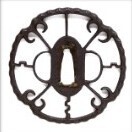Silk-Goods Lane, Odenma-cho
Utagawa Hiroshige Japanese, 1797–1858. Silk-Goods Lane, Odenma-cho, No. 74 from One Hundred Famous Views of Edo, 7th month of 1858.
The procession is moving along one of the streets in Odenmacho, a wealthy central quarter of the capital, adjoining the Nihonbashi. This quarter, which appeared as the focus of the transport system linking Edo with the rest of the country, became with time one of the busiest shopping areas in the city. Silk fabrics were the main goods sold here and shops selling them could make up whole streets. The print shows the quarter's Third Street, where the largest firms had their trading premises. The most prominent such business was Daimura and the decoration of the awnings and the advertising sign in front of the entrance here feature its trade mark - a circle (maru) containing the character meaning 'big' (dai).
The sign proclaims 'All sorts of fabric' and, higher up, either side of the trade mark 'Payment in cash. Prices are not negotiable.' This way of trading was introduced by another cloth dealer in the late seventeenth century...


